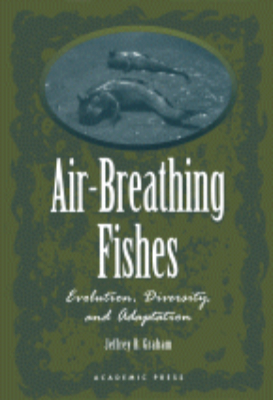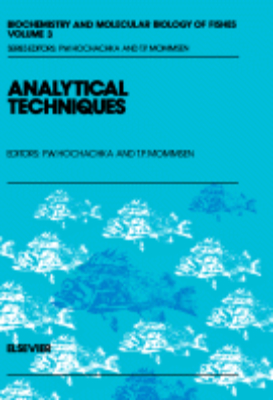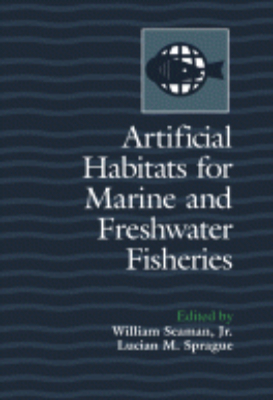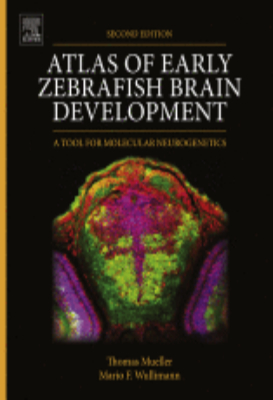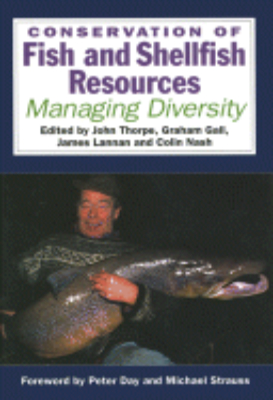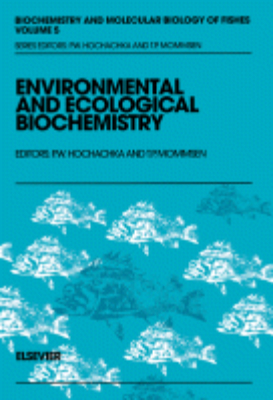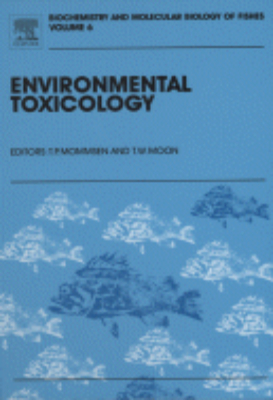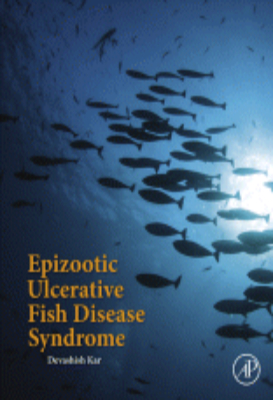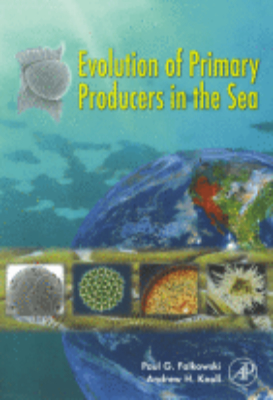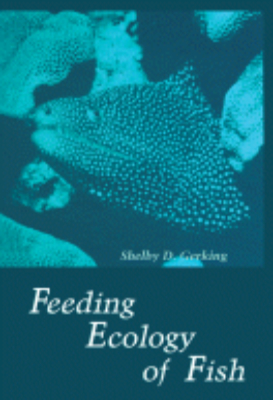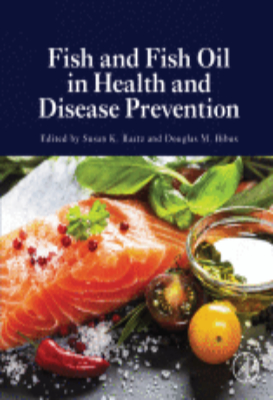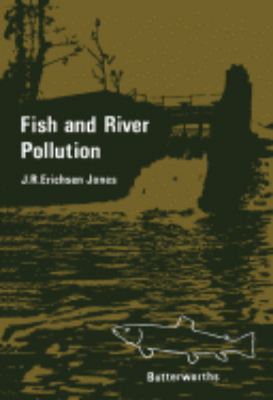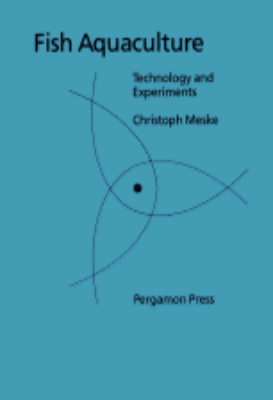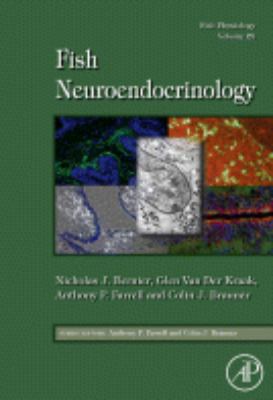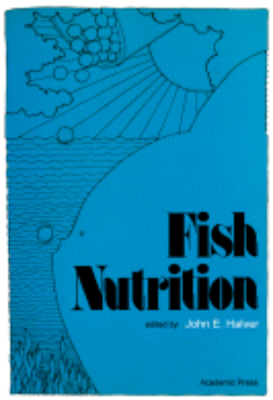E-Resources
Air-Breathing Fishes
"Air Breathing Fishes: Evolution, Diversity, and Adaptation is unique in its coverage of the evolution of air-breathing, incongruously because it focuses exclusively on fish. This important and fascinating book, containing nine chapters that present the life history, ecology, and physiology of many air-breathing fishes, provides an exceptional overview of air-breathing biology.Each chapter provides a historical background, details the present status of knowledge in the field, and defines the questions needing attention in future research. Thoroughly referenced, containing more than 1,000 citations, and well documented with figures and tables, Air-Breathing Fishes is comprehensive in its coverage and will certainly have wide appeal. Researchers in vertebrate biology, paleontology, ichthyology, vertebrate evolution, natural history, comparative physiology, anatomy and many other fields will find something new and intriguing in Air-Breathing Fishes. Key Features. Offers a complete overview of an important and immensely interesting area of research. Provides a perspective of air-breathing fish that spans 300 million years of vertebrate evolution. Contains numerous illustrations as well as comprehensive charts. Provides a synoptic treatment of all the known air-breathing species with important data on their morphological and physiological adaptations"
Antarctic Fish Biology
This important volume provides an original synthesis and novel overview of Antarctic fish biology, detailing the evolution of these fish in some of the most unusual and extreme environments in the world. Focusing on one group of fish, the notothenoioids, which contain the majority of the current organismal diversity, this book describes a fauna that has evolved in isolation and experienced incredible adaptive radiation by acquiring numerous physiological specializations. Darwin's finches and African cichlids may be joined by Antarctic fishes as exemplars of adaptive radiation.The books' coverage is detailed and comprehensive, and the author clearly recognizes the fact that these fish are a component of a most interesting and biologically unique ecosystem and environment. Topics inAntarctic Fish Biologyinclude past and present environments, fossil records, taxonomic composition of fauna, systematic relationships, diversification, and physiological adaptations.
Approaches to Research on the Systematics of Fish-Borne Trematodes
"Approaches to Research on the Systematics of Fish-Borne Trematodes is a concise guide for systematic studies of the prevalence of fish-borne trematodes both in the endemic areas and experimental laboratories. It includes methods to identify species of fish-borne trematodes to enhance the precision of research studies based on the metacercarial stage. Misidentification of trematode species is a common occurrence when researchers are new to the field and have no guidance. Consequentially, sometimes publications report inaccurate prevalence rates of these parasites. This compact guide gives clear direction on:. Collection of parasites in the final hosts. Collection of cercaria from snail first intermediate hosts. Collection of metacercaria from fish hosts. Molecular identification of parasites. Systematics of fish-borne trematodes Key Features. Provides research guidelines and protocols for studying systematics of fish-borne trematodes using both morphological and molecular data. Presents keys to enable identification of metacercariae of fish-borne trematodes in the Greater Mekong subregion"
Aquatic Ecosystems
"Aquatic Ecosystems explains the interplay between various movements of matter and energy through ecosystems mediated by Dissolved Organic Matter. This book provides information on how much DOM there is in a particular aquatic ecosystem and where it originates. It explains whether the DOM composition varies from time to time and place to place. It also details how DOM becomes incorporated into microbial food webs, and gives a better, clarifying, understanding to its significance of DOM. Key Features. There are many ways to study DOM and this book focuses on several central questions: How much DOM is there in a particular aquatic ecosytem Where does it come from Does the composition of the DOM vary from time to time and place to palce. How does DOM become incorporated into microbial food webs, which are the basis of plant, invertebrate and vertebrate food webs. How can the answers to these and other questions about DOM be considered together so that a better understanding of the significance of DOM can emerge"
Artificial Habitats for Marine and Freshwater Fisheries
"Artificial habitats have been used for centuries to successfully modify environments for the benefit of Man. In the aquatic environment, the use of artificial habitat technologies is of growing interest worldwide. Opportunities exist in both developed and developing nations to apply these technologies in many areas, including classical scientific investigations of ecosystem structure and function, engineering advances in underwater technology, and fisheries and environmental management. The applications of artificial habitat technologies are taking on ever greater economic, social, and environmental importance globally, not only in developed countries such as Japan where highly sophisticated technologies are used, but also in developing nations, where lower cost practices are in use. There is growing pressure to increase production, while at the same time preserve or enhance the environments and ecosystems surrounding fisheries. This book provides a comprehensive review of the facts, issues, and global trends emerging regarding the use of artificial habitats in aquatic ecosystems. It presents the most recent scientific advances in ecology and engineering technologies related to the building of artificial habitats, and it also presents many of the fisheries management and socioeconomic and environmental issues. Artificial Habitats for Marine and Freshwater Fisheries will be of interest to a broad audience including natural resource scientists, planners, and managers, particularly those interested in aquatic and fisheries science and management; organizations and individuals interested in commercial and recreational fishing; ecologists; environmental economists, engineers, lawyers, and social scientists; and geographers. Key Features. Presents a global scope. Draws together, for the first time, disparate literature. Contains contributions by authors in the United States and Japan. Features engineering chapters that focus on Japanese advanced technology often not available to the English language audience"
Atlas of Early Zebrafish Brain Development
"Atlas of Early Zebrafish Brain Development: A Tool for Molecular Neurogenetics, Second Edition, remains the only neuroanatomical expression atlas of important genetic and immunohistochemical markers of this vertebrate model system. It represents a key reference and interpretation matrix for analyzing expression domains of genes involved in Zebrafish brain development and neurogenesis, and serves as a continuing milestone in this research area. This updated volume provides in-situ hybridized and immunostained preparations of complete series of brain sections, revealing markers of the fundamental stages in the life history of neuronal cells in very high quality preparations and photographic plates. Specific additions to this edition include documentation on the distribution of neurons expressing GABA, dopamine and serotonin, material on the basal ganglia, hypothalamus, and the caudal, segmented part of the diencephalon, new theories on the early organization of the telencephalon and thalamus, and integration of a comparative perspective on the mid- and hindbrain. Key Features. Documentation on the distribution of neurons expressing GABA, dopamine and serotonin. Material on the basal ganglia, hypothalamus, and the caudal, segmented part of the diencephalon. New theories about the early organization of the telencephalon and thalamus. Integration of a comparative perspective on the mid- and hindbrain"
Atlas of Zebrafish Development
"Zebrafish are widely considered an excellent model system for vertebrate development. The embryo is transparent, thereby enabling visualization and use of labelling and transgenic approaches. Moreover, because of the ease of inducing new mutations in zebrafish and similarity with the human genome, this organism may be used effectively for disease studies. For example, mutant zebrafish are being utilized for testing drugs that will combat a range of human diseases, from Alzheimer's and cancer to kidney failure and congenital heart disease. For the first time, this atlas provides the research community with a complete reference for zebrafish anatomy spanning the early embryo all the way to adulthood. The authors employ the technique of optical projection tomography (OPT), and offer a series of sections in multiple planes from each sample. The contents are organized by developmental stages, with over 200 images that contain annotations describing anatomical structures relevant to development. In addition, chapters feature explanatory text that highlights major developments in the zebrafish during each stage. Key Features. Provides the first comprehensive anatomical resource that covers all regions of zebrafish anatomy from the larval period to adulthood. The over 200 images include explanatory notes. Each chapter contains a concise description of key anatomical features that factor in zebrafish development. Despite many years of use as a model system, until now there has never been a guide to zebrafish at the larval stage. The book's website contains a database of over 10k sections from different regions as well as 3D images that are interactive"
Biology and Evolution of the Mexican Cavefish
"Biology and Evolution of the Mexican Cavefish features contributions by leading researchers in a comprehensive, unique work that examines a number of distinct areas of biologyevolution, development, ecology, and behaviorusing the Mexican cavefish as a powerful model system to further understanding of basic biological processes such as eye degeneration, hearing, craniofacial development, sleep, and metabolic function. These fish are currently being used to better understand a number of issues related to human health, including age-related blindness, sleep, obesity, mood-related disorders, and aging. The recent sequencing of the cavefish genome broadens the interest of this system to groups working with diverse biological systems, and has helped researchers identify genes that regulate sleep, eye degeneration, and metabolic function. Mexican cavefish are particularly powerful for the study of biological processes because these fish evolved independently in twenty-nine caves in the Sierra de el Abra Region of Northeast Mexico. These fish have dramatic adaptations to the cave environment, and this can be used to identify genes involved in disease-related traits. This scholarly text will be of interest to researchers and students throughout diverse areas of biology and ecology. It includes photographs of animals and behavior in laboratory and natural settings that will also increase interest and accessibility to non-experts.. Key Features. Includes a mixture of images and illustrations such as the geographical distribution of cave pools and the developmental biology of the nervous system. Features a companion site with geographical maps. Fills a notable gap in the literature on a topic of broad interest to the scientific community. Presents the recent sequencing of the cavefish genome as a groundbreaking development for researchers working with diverse biological systems"
Conservation of Fish and Shellfish Resources
"Fish and shellfish comprise annually nearly 70-million tons of the world's edible animal protein. However, because of this demand, previously vast stocks have often been exhausted to the point of near extinction. The first book of its kind in the area of freshwater/marine biodiversity, this extensive work reviews the present status of genetic resource management, its needs and constraints, various intervening human factors such as pollution and overfishing, and problems posed by different species and life-styles. This discussion of the conservation of fish and shellfish resources is illustrated by four diverse groups: Atlantic salmon, cupped oysters, common and Chinese carp, and Nile tilapia. These results, produced by the collaboration of nine leading population and production geneticists, aquaculturists, and behavioral and developmental ecologists should become a fundamental resource useful to biologists, scientists and advisors exploring current issues in the fishery sciences. Key Features. Four page color plate section. Database of key organizations for contact purposes. Foreword by Dr. Mike Strauss, Am. Assoc. for the Advancement of Science; and Dr. Peter Day, Rutgers University. Four in-depth case studies by international experts. Editors are major names in marine/freshwater fisheries science. Originally sponsored and reviewed by U.S. National Academy of Sciences"
Coral Reef Fishes
"Coral Reef Fishes is the successor of The Ecology of Fishes on Coral Reefs. This new edition includes provocative reviews covering the major areas of reef fish ecology. Concerns about the future health of coral reefs, and recognition that reefs and their fishes are economically important components of the coastal oceans of many tropical nations, have led to enormous growth in research directed at reef fishes. Coral Reef Fishes is much more than a simple revision of the earlier volume; it is a companion that supports and extends the earlier work. The included syntheses provide readers with the current highlights in this exciting science. Key Features. An up-to-date review of key research areas in reef fish ecology, with a bibliography including hundreds of citations, most from the last decade. Authoritative, up-to-date, provocative chapters written to suggest future research priorities. An important companion and successor to The Ecology of Fishes on Coral Reefs. Includes discussions of regulation of fish populations, dispersal or site fidelity of larval reef fishes, sensory and motor capabilities of reef fish larvae, and complexities of management of reef species and communities"
Economic Aspects: Fisheries and Culture
The Biology of Crustacea, Volume 10: Economic Aspects: Fisheries and Culture focuses on economic aspects of elements of crustacean biology associated primarily with the production of human food, namely, fisheries and culture. Organized into five chapters, this book deals first with the groups comprising the commercially important shrimps and prawns and their near relatives, as well as the generally used fishing method. It then describes the role and impact of body form in the biology and especially the fisheries of crabs. Subsequent chapter centers on lobsters and their kin, particularly the impact on fisheries methods and management approaches of behavioral responses to environment, modes of reproduction, recruitment, and population dynamics. Culture methods and factors important in managing systems through water quality control are then reported. Lastly, large-scale culture of major decapod groups, including the general biological characteristics of decapods relevant to aquaculture, is presented. This book will help stimulate the further exploration of some of the most fascinating and exciting problems in applied crustacean biology.
Epizootic Ulcerative Fish Disease Syndrome
"Epizootic Ulcerative Fish Disease Syndrome covers both the background and current information on the EUS disease relevant to fisheries and aquaculture delivered in a systematic and succinct way. The book is an essential resource for the aquaculture and fisheries researcher interested in finding solutions to the spread of the disease across the globe and students in relevant programs, including an in-depth description and analysis of the disease, as well as the structure and composition of the virus, while offering prevention and control methodologies. Clinical veterinarians, aquaculture disease practitioners, farmers, and those who are interested in aquatic virology will find this book to be a useful guide on the topic. Key Features. Examines different manifestations of the disease, and includes different methodologies of studies, such as histopathological, histochemical, bacteriological, mycological, virological, and enzymological. Provides background information describing fish as a significant food source and avocation, the diversity of fishes in the globe, and the panorama of diseases fish can be exposed to. Describes all major species affected by EUS and its pattern of spread, along with suggested strategies for control and prevention"
Evolution of Primary Producers in the Sea
"Evolution of Primary Producers in the Sea reference examines how photosynthesis evolved on Earth and how phytoplankton evolved through time ultimately to permit the evolution of complex life, including human beings. The first of its kind, this book provides thorough coverage of key topics, with contributions by leading experts in biophysics, evolutionary biology, micropaleontology, marine ecology, and biogeochemistry.This exciting new book is of interest not only to students and researchers in marine science, but also to evolutionary biologists and ecologists interested in understanding the origins and diversification of life. Evolution of Primary Producers in the Sea offers these students and researchers an understanding of the molecular evolution, phylogeny, fossil record, and environmental processes that collectively permits us to comprehend the rise of phytoplankton and their impact on Earth's ecology and biogeochemistry. It is certain to become the first and best word on this exhilarating topic. Key Features. Discusses the evolution of phytoplankton in the world's oceans as the first living organisms and the first and basic producers in the earths food chain. Includes the latest developments in the evolution and ecology of marine phytoplankton specifically with additional information on marine ecosystems and biogeochemical cycles. The only book to consider of the evolution of phytoplankton and its role in molecular evolution, biogeochemistry, paleontology, and oceanographic aspects. Written at a level suitable for related reading use in courses on the Evolution of the Biosphere, Ecological and Biological oceanography and marine biology, and Biodiversity"
Feeding Ecology of Fish
Feeding Ecology of Fish establishes a comprehensive framework for the variable ecological patterns exemplified by feeding fishes. The author, a former president of the American Fisheries Society, devotes special attention to synthesizing empirical studies in categorizing feeding patterns. This book shows how remarkably adaptable fish can be with regard to selecting food, often from trophic levels not usually occupied. Relying on a thorough literature survey, Feeding Ecology of Fish will be an invaluable reference for both fishery scientists and ecological theorists. Key Features @introbul:Special features include: @bul:* Organization by trophic level * Emphasis on empirical studies * Broad coverage of a diverse field
Fish and Fish Oil in Health and Disease Prevention
"Fish and Fish Oil in Health and Disease Prevention provides an authoritative review of the role of fish and fish oil intake in the promotion of human health. This up-to-date volume provides a complete examination of intake patterns as well as research evidence of intake in disease prevention and treatment. Readers will gain knowledge ranging from the current state of fish and fish oil intake, their health promoting effects and influences on individual response, how they influence development and health maintenance through the life cycle, and their role in disease prevention and treatment. This book is an invaluable resource for all researchers working to understand the relationship between fish and human health. It is a valuable reference for nutritionists, dietitians, and health care providers. Key Features. Imparts a valuable understanding of fish intake patterns around the world and the role of fish and fish oil in human health through the lifecycle. Offers an understanding of the role of fish and fish oil in disease risk reduction and treatment. Presents the current status of fish intake and recommended intake levels for human health. Focuses on research on unique fish and oil sources and potential problems with fish availability"
Fish and River Pollution
Fish and River Pollution deals with experimental and field research connected with the effects of pollution in fish, and the useful data gathered from these studies. After reviewing some experiments made on the effects of pollution on fish, the author discusses pollution by oxygen-reducing effluents such as sewage, milk washing, and other solutions that can be broken down by microorganisms, a process that uses up dissolved oxygen in the water. The experiments conducted by Shelford and Allee, which the author cites, studies the reactions of fish to different concentrations of atmospheric gases, particularly as fish detect low concentrations of oxygen more sensitively than man. The paper also discusses the time-effect relationship of a toxic substance to fish as immersion time, time needed for advancement, minimum time of exposure, and immersion time to fatality. The effect of thermal pollution such as that generated in thermal plants to produce electricity, though chemically toxic-free, can significantly change the temperature of the water where fish live. Such temperature change can affect water viscosity, rate of water oxygen absorption, development of sewage fungus, and changes in natural invertebrate fauna. This book can be appreciated by environmentalists, aquatic researchers, zoologists, and marine biologists.
Fish Aquaculture
Aquaculture has gained a momentum throughout the world during recent decades which is unparalleled in other branches of food production. This book describes methods currently used for the production of those warm water table fish which are of major importance. Included are experiments and procedures which will help to combat the growing food problem through new production methods for animal protein. The aim of the work presented here is to promote the continuous production of warm water table fish independently of climate or environment within the least necessary space and even in regions with unsuitable weather or topography.
Fish Immunology
Fish Immunology contains the proceedings of a symposium organized by the Fisheries Society of the British Isles, held in Plymouth, England, 11-13 July 1983. This volume contains 29 chapters and opens with a study on the prevention of disease outbreak or treatment of disease in fish farms with drugs or chemicals. Separate chapters follow on topics such as immune phenomena in Teleostei or Anura; phagocytosis in fish; the granulocytes of three elasmobranch species, namely Scyliorhinus canicula, Raja clavata and R. microcellata; and phagocytic cells in the dogfish (Scyliorhinus canicula l.); and levels of -precipitin in two groups of wild fish: a group believed to be suffering from Ulcerative Dermal Necrosis (UDN) and a healthy group showing no external evidence of disease. Subsequent chapters deal with sequential antigenic competition in teleosts challenged with the fish-furunculosis bacterium Aeromonas salmonicida; the occurrence of vaccine uptake at the skin surface of rainbow trout; and vaccination and development of immunological memory in carp.
Fish in Research
Fish in Research comprised of papers presented at a symposium entitled ""Fish in Research"" sponsored by the University of South Dakota in Vermillion. The purpose of the symposium was to ask those directly involved in research on fish, ""What unique information of biochemical and physiological processes can be gained by using fish as experimental animals"" The book presents the environment aspects of neoplasia in fishes; experimental fish neoplasia; and the comparative aspects of neoplasia in fish and other laboratory animals. The text also includes papers on the control of cholesterol synthesis in normal malignant tissue; the biochemical aspects of salt; and steroidogenesis in fish. Papers on the lipid catabolism in fish muscle; the contrasts between fish and warm blooded vertebrates in enzymes systems of intermediary metabolism; and quantitative inheritance and environmental response of rainbow trout are also considered. The book further tackles the blood groups in salmonid fishes; ontogeny of lactate dehydrogenase isozymes in trout; and amino acid and protein requirements of fish. The text also looks into the inorganic salt effects on growth; salt water adaption; and gill ATPase of pacific salmon. Zoologists and scientists involved in fisheries research will find the book invaluable.
Fish Nutrition: 1972
Fish Nutrition aims to present the state of knowledge of basic and applied nutritional requirements of fishes. Most of the information found in this book involves salmonids, their nutrition, and metabolism of nutrients. This is in view of the fact that more research has been done and completed with this fish. Although applied fish nutrition is a very broad field, this book focuses on some of its aspects. These include the classes of nutrients and requirements for several types of fishes. This book comprises of 11 chapters. The first few chapters deal with the general nutrient requirements of fishes. Then, other chapters discuss calorie and energy as well as micro- and macronutrient needs and requirements. The following chapters deal with the non-nutrient components of the diet, or those that influence the characteristics of food products including texture, odor, flavor, and color. Other topics covered are enzymes and systems of intermediary metabolism (Chapter 6); feed formulation and evaluation (Chapter 7); and salmonid husbandry techniques (Chapter 9). Nutritional fish diseases are also discussed in this book. Some of these diseases include thyroid tumor, gill disease, anemia, lipoid liver degeneration, and visceral granuloma. In Chapter 11, the relationship of nutrition and pathology is given emphasis. This chapter also tackles the diet and general fish husbandry. This topic is very important, because an adequate diet for fish husbandry is the foundation of fish farming.

